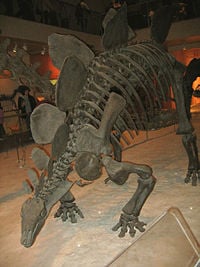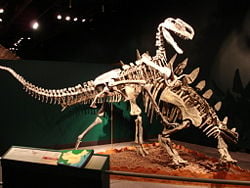Stegosaur
| Stegosaurians
| ||||||||||||||
|---|---|---|---|---|---|---|---|---|---|---|---|---|---|---|
 Fossil skeleton of a Stegosaurus,
National Museum of Natural History | ||||||||||||||
|
Extinct (fossil)
| ||||||||||||||
| Scientific classification | ||||||||||||||
| ||||||||||||||
|
Huayangosauridae |
Known colloquially as stegosaurs, the Stegosauria are a group of herbivorous dinosaurs of the Jurassic and Early Cretaceous Periods, being found mostly in the Northern Hemisphere, predominantly in what is now North America and China. Their geographical origins are unclear; the earliest stegosaurs have been found in China, although fragmentary material hails from southern England.
The genus Stegosaurus, from which the group acquires its name, is by far the most famous stegosaurian.
Paleobiology
All stegosaurs have rows of special bones, called osteoderms, which develop into plates and spines along the back and tail. Many also have intermediate ones, called 'splates'.
Skull
They had characteristic long, narrow heads and a horn-covered beak or rhamphotheca, which covered the front of the upper jaw (premaxillary) and lower jaw (predentary) bones. Similar structures are seen in turtles and birds. Apart from Huayangosaurus, stegosaurs subsequently lost nearby premaxillary teeth.[1]
Posture
All are quadrupedal, with hoof-like toes on all four limbs. All stegosaurians after Huayangosaurus have forelimbs much shorter than their hindlimbs. Given that their speed would have been limited by their shortest limb and their size is likely to have precluded them from being bipedal, this suggests that they were not able to run quickly.
Taxonomy
The Stegosauria was originally named as an order within Reptilia by O.C. Marsh in 1877,[2] although today it is generally treated as an infraorder or suborder (or simply a clade) within Thyreophora, the armored dinosaurs. It includes the families Huayangosauridae and Stegosauridae.
The Huayangosauridae were an early family of stegosaurs which lived during the early to middle Jurassic Period. In general, they were smaller than later stegosaurs and had shorter and higher skulls. Currently, the only confirmed genus included is the type genus Huayangosaurus of China. The poorly-known remains of Regnosaurus from England, however, indicate it too could be a member. Its lower jaw is very similar to the former.
The vast majority of Stegosaurian dinosaurs thus far recovered being to the Stegosauridae, which lived in the later part of the Jurassic and early Cretaceous, with one possible genus (Dravidosaurus) from the late Cretaceous. It includes the well-known Stegosaurus. The family is widespread, with members across the Northern Hemisphere and Africa.
Classification

Following is a list of stegosaurian genera by classification and location:
Suborder Thyreophora
Infraorder Stegosauria
- Gigantspinosaurus
- Family Huayangosauridae
- Huayangosaurus (Sichuan,China)
- ?Regnosaurus (Sussex, United Kingdom)
- ?Tatisaurus (Yunnan,China)
- Family Stegosauridae
- Paranthodon - (South Africa)
- Monkonosaurus - (Tibet, China)
- Chungkingosaurus - (Chongqing, China)
- Chialingosaurus - (Sichuan, China)
- Wuerhosaurus - (Xinjiang, Western China)
- Hesperosaurus - (Wyoming, USA)
- Dacentrurus - (United Kingdom, France & Spain)
- Subfamily Stegosaurinae
- Uncertain placement (incertae sedis)
Phylogeny
Kenneth Carpenter of the Denver Museum of Nature and Science published a preliminary phyletic tree[3] of stegosaurs, in the 2001 description of Hesperosaurus. Here, the basal stegosaur Huayangosaurus is used as the outgroup. The Stegosauridae are then defined as all stegosaurs closer to Stegosaurus than to Huayangosaurus. The position of Chungkingosaurus is uncertain due to lack of data.
Stegosauria
|—Huayangosaurus
`—Stegosauridae
`—+-?Chungkingosaurus
`—+--Chialingosaurus
`—+--+—Wuerhosaurus
| `—+--Dacentrurus
| `—Hesperosaurus
`—+--Tuojiangosaurus
`—+--+—Kentrosaurus
| `—Lexovisaurus
`—+--Stegosaurus stenops
`—S. ungulatus (=?S. armatus)
Undescribed species
To date, several genera from China bearing names have not been formally described: Gigantspinosaurus, "Changdusaurus" and "Yingshanosaurus". Until formal descriptions are published, each of these genera is regarded as a nomina nuda.
ReferencesISBN links support NWE through referral fees
- ↑ Sereno, P & Z-M Dong (1992). The skull of the basal stegosaur Huayangosaurus taibaii and a cladistic diagnosis of Stegosauria. Journal of Vertebrate Paleontology 51: 318-343
- ↑ Marsh, O.C. (1877). "New order of extinct Reptilia (Stegosauria) from the Jurassic of the Rocky Mountains." American Journal of Science, 14(ser.3):513-514.
- ↑ Carpenter, K., Miles, C.A., and Cloward, K. (2001). "New Primitive Stegosaur from the Morrison Formation, Wyoming", in Carpenter, Kenneth(ed) The Armored Dinosaurs. Indiana University Press. ISBN 0-253-33964-2, 55–75.
- Fastovsky DE, Weishampel DB (2005). "Stegosauria:Hot Plates", in Fastovsky DE, Weishampel DB: The Evolution and Extinction of the Dinosaurs (2nd Edition). Cambridge University Press, 107–130. ISBN 0-521-81172-4.
External links
- http://www.palaeos.com/Vertebrates/Units/320Ornithischia/320.200.html
- http://www.kheper.net/evolution/dinosauria/Stegosauria.htm
Credits
New World Encyclopedia writers and editors rewrote and completed the Wikipedia article in accordance with New World Encyclopedia standards. This article abides by terms of the Creative Commons CC-by-sa 3.0 License (CC-by-sa), which may be used and disseminated with proper attribution. Credit is due under the terms of this license that can reference both the New World Encyclopedia contributors and the selfless volunteer contributors of the Wikimedia Foundation. To cite this article click here for a list of acceptable citing formats.The history of earlier contributions by wikipedians is accessible to researchers here:
The history of this article since it was imported to New World Encyclopedia:
Note: Some restrictions may apply to use of individual images which are separately licensed.